by Mike Hays

Sheet music for “Every Day Will Be Sunday When the Town Goes Dry (1918–1919)” Source: University of Maine via Wikipedia
Prohibition became official nationwide 100 years ago on January 17, 1920. Hollywood portrays the prohibition era of the 1920s as one glamorous evening with password-encoded speakeasies (also referred to as “speaks,” “blind tigers,” and “blind pigs”) where carousing flappers and wealthy tuxedoed men danced to swinging jazz while armed bootleggers smiled. Surely, Nyack must have escaped this wide-spread flaunting of prohibition so common in New York City. All the saloons became ice cream shops, didn’t they?
The truth is, at the height of prohibition in 1928, Nyack Chief of Police Walter Vandaman estimated that at least 37 speakeasies operated in Nyack. This would be one speakeasy for every 170 people living in Nyack, including children. This count doesn’t include nearby farm stills that, according to Rockland historian Craig Long, could be found in attics, basements, barns, root cellars, and even outhouses. And according to Long, sometimes tea rooms, of all places, were known to add something special to tea. It’s possible that there were more places selling alcohol during prohibition than before.
Stories from prohibition days in Nyack are hard to come by. Alcohol was illegal and people didn’t talk about speakeasies much in public during or after Prohibition. The only Nyack tavern remaining from the speakeasy days is OD’s Tavern, now a warm and cozy farm-to-table restaurant.
A short history of how prohibition happened
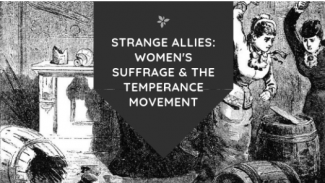 The temperance movement started as a religious movement in the early 19th century. By 1851, alcohol was already prohibited in the state of Maine. The Woman’s Christian Temperance Union was formed in the later part of the 19th century, focusing on temperance, women’s rights, and suffrage, for which the Constitution was amended in parallel with prohibition.
The temperance movement started as a religious movement in the early 19th century. By 1851, alcohol was already prohibited in the state of Maine. The Woman’s Christian Temperance Union was formed in the later part of the 19th century, focusing on temperance, women’s rights, and suffrage, for which the Constitution was amended in parallel with prohibition.
The movement picked up steam in the early 20th century. By the time the constitutional amendment was brought forward, 24 states already had prohibition. In World War I, a law was passed making it illegal to provide a man in uniform with alcohol. In New York, the making of beer and whiskey were terminated in June, 1919. Only Connecticut, New Jersey, and Rhode Island did not vote in favor of the 18th amendment.
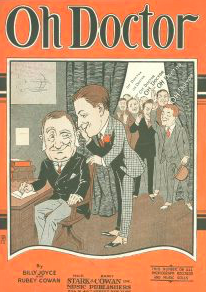 The Volstead Act was passed by Congress to define what prohibition meant in practice. Alcohol could be stored and consumed at home for the exclusive use by the owner, family, and friends. Wealthy homeowners were known to buy up and store the entire contents of a liquor store. Intoxicating liquors could be obtained with a doctor’s prescription, no more than one pint every ten days. Wine could only be used for sacramental purposes.
The Volstead Act was passed by Congress to define what prohibition meant in practice. Alcohol could be stored and consumed at home for the exclusive use by the owner, family, and friends. Wealthy homeowners were known to buy up and store the entire contents of a liquor store. Intoxicating liquors could be obtained with a doctor’s prescription, no more than one pint every ten days. Wine could only be used for sacramental purposes.
New York State added a kicker to the Volstead Act. The Mullen-Gage Act, known as a “little Volstead Act,” allowed individuals to sue intoxicated persons for damages, and permitted police to stop-and-frisk anyone, anywhere, at any time. The Mullen-Gage Act was repealed in 1923, during the term of “wet” Governor Al Smith.
Did doctors abuse their scrip-writing authority?
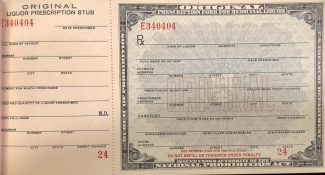
Dr. Schechner’s prescription pad, courtesy of Myra Sharp
Myra Starr, South Nyack historian, has retained her father’s prescription book for alcohol along with the codes for 27 allowable illnesses. Dr. Abraham Schechner wrote a small number of prescriptions for spirits in 1931 and 1932, principally for acute coryza and grippe. No one seems to have returned for a renewal to their prescription. At least in Nyack, doctors were not a source.
Rockland speakeasies

Post-Prohibiton Journal News ad for the many dance halls in Rockland in the 1930s.
A Nyack Evening Journal expose in 1928 focused on Orangeburg speakeasies, apparently catering to the workers building the Rockland Lake State Hospital. Residents had complained that the Muller-Gage Act repeal left control of speaks out of the hands of locals. According to one Norwegian worker, “If Orangeburg goes dry, we get it in Tappan, Sparkill, Piermont, or Nyack, and we move there so that we can get it when we want it.”
In 1930, a giant still in Mt. Ivy was busted causing Haverstraw speakeasies to go quiet for fear of federal raids. Fake agents often tried to con speaks. In 1927, three pseudo-federal agents went around to speaks in Nyack demanding subscription money. After being informed of the problem, Police Commissioner Haire went to the Opera House at Franklin and Hudson Streets, where the men were staying, and suggested they leave. “When we get back on the federal force, we’ll see that you are raided,” they were alleged to have said as they left town.
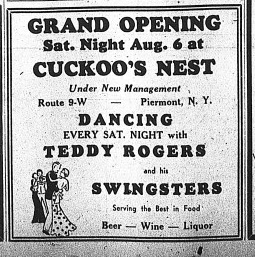 Near the end of Prohbition in 1933, things were more loosey-goosey, as 3.2% beer became legal. The Journal News reports of a ruckus at the Cuckoo’s Nest in Sparkill caused by a busload of Brooklynites getting upset when the beer mugs in which they were served on the bus were collected by the bartender. The visitors started a brawl and cleared the mustard jars, napkin holders, glasses, and salt shakers from the counter. Orangetown Police Chief Stern arrested one person who was released with a promise to leave the village peacefully.
Near the end of Prohbition in 1933, things were more loosey-goosey, as 3.2% beer became legal. The Journal News reports of a ruckus at the Cuckoo’s Nest in Sparkill caused by a busload of Brooklynites getting upset when the beer mugs in which they were served on the bus were collected by the bartender. The visitors started a brawl and cleared the mustard jars, napkin holders, glasses, and salt shakers from the counter. Orangetown Police Chief Stern arrested one person who was released with a promise to leave the village peacefully.
Orangetown speakeasies raided
Inherent in the term speakeasies is that they were not publicized. So it’s difficult now to reconstruct where they were. One such large-scale bust happened in and around Nyack on May 22, 1931.
An undercover agent cased Orangetown “joints” on May 13, 1928, and federal agents carried out six simultaneous daylight searches on May 22 with nine owners and bartenders arrested. There was almost no time for surprised customers and bartenders to notify other speakeasies of the raids. Other speaks turned off their lights and closed curtains until people were sure agents had left. The Nyack police first became aware of the raid when they were called to cart 24 cases of beer to the Nyack lock-up from Schilling’s at 7 Piermont Ave in Nyack.
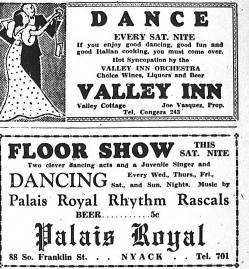 The owner of the Valley Cottage dance club, Valley Inn, at the corner of Lake Road and King’s Highway, was arrested for a small amount of liquor. The owner’s other dance club, the Palais Royal, was not raided.
The owner of the Valley Cottage dance club, Valley Inn, at the corner of Lake Road and King’s Highway, was arrested for a small amount of liquor. The owner’s other dance club, the Palais Royal, was not raided.
A bar, called by the newspaper, “the former Wipper place on Main Street in Nyack,” was busted for small quantities. The owner and bartender were arrested.

From the Nyack Library Collection this hand-labeled photo made just before the destruction of Chase St. in South Nyack in 1952 shows two taverns that were speakeasies during Prohibition.
The last of the six speakeasies raided was the newly opened Cuckoo’s Nest. The owner, Anthony Fenninger, was busted for having a quantity of home brew. The Cuckoo’s Nest was located at 9W and Hickey Street in Sparkill, near the viaduct.
Later in 1928, local police went into action. Chief Vardaman issued shut-down notices to seven speakeasies on Main and Franklin Streets in Nyack. In the words of Chief Vardaman, “these places have flooded our streets with drunkards. The chief further remarked, “they are like the ancient serpent conquered by Hercules. Each time Hercules cuts off one head of the snake, seven more appeared.”
Tales of the speakeasy at OD’s Tavern

Photo of Rose Maggio in front of her cigar store in 1930 (Courtesy OD’s Tavern)
O’Donoghue’s Tavern (affectionately known as OD’s locally) opened ten years before Prohibition, in 1909, under another name. The tavern, once a stable for the firehouse, was located behind Maggio’s Cigar Shop, which faced Main Street. Like the cigar store, the tavern was attached to the next door Mazzepa Engine Company #2 firehouse. OD’s current owners, Geoff Torrens and Dianne Fuhrman, relate some of the stories that have trickled down over time from former owner Kevin O’Donoghue and others.
After prohibition, the tavern became a speakeasy, serving alcohol when the coast was clear. How did they know the coast was clear? An underground channel of communication was open between speaks and those charged with enforcing prohibition.
In the case of OD’s, extra speakeasy security was possible since the tavern could be accessed only indirectly by doors that connected to the fire station and the cigar store. A red light on the door to the fire station would alert the bar that someone wanted in. A doorbell and peephole system was used to verify who wanted to come in from the cigar store.

The front of OD’s was once Maggio’s cigar store. The Mazeppa fire house is just to the left.
Neighbors who lived across the street remember seeing people emerge from the cigar shop with a bottle and cigars. Kevin O’Donoghue repeats the tale that the Nyack mayor was seen carrying liquor in and out of the tavern. There is no record of the tavern ever being cited or raided but apparently a system was in place with a chute to the basement to quickly hide liquor.
The moral of the story?
That prohibition was a failure was obvious to most from its beginnings. It was impossible to enforce and the federal government lost tax revenue. Temperance played out as another one of America’s culture and political wars–a type we have been doomed to repeat many times since. Nyack, like other American towns and cities, survived prohibition with an array of speakeasies and a whisper campaign. How the speaks worked in detail and where they were located is mostly lost to time; our only direct link is OD’s Tavern, a fit and wholesome museum for the prohibition era in Nyack.
Michael Hays is a 30-year resident of the Nyacks. Hays grew up the son of a professor and nurse in Champaign, Illinois. He has recently retired from a long career in educational publishing with Prentice-Hall and McGraw-Hill. Hays is an avid cyclist, amateur historian and photographer, gardener, and dog walker. He has enjoyed more years than he cares to count with his beautiful companion, Bernie Richey. You can follow him on Instagram as UpperNyackMike.

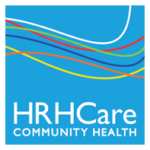 Nyack People & Places, a weekly series that features photos and profiles of citizens and scenes near Nyack, NY, is brought to you by HRHCare and Weld Realty.
Nyack People & Places, a weekly series that features photos and profiles of citizens and scenes near Nyack, NY, is brought to you by HRHCare and Weld Realty.








